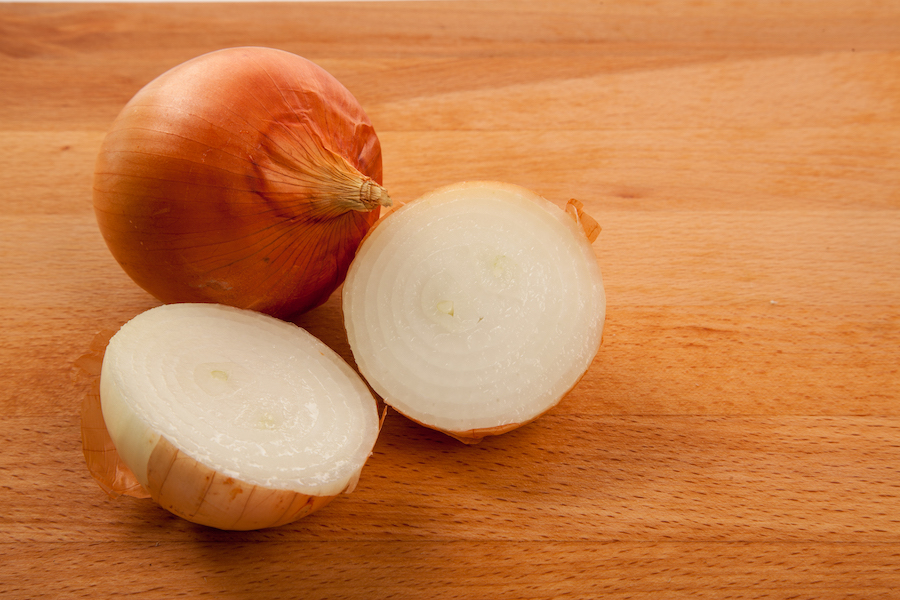There is an adage that is going round and round on the internet that onions help reduce new paint smell. In all of the articles out there, no chemist was named or sourced.
So I wanted to get to the bottom of this to see if it was really true. I talked to two chemists to see if this was a likely chemical reaction. There aren’t any studies directly looking at onions and new paint (or other VOC-producing products), but they still had specific ideas on the chemical reaction that is likely taking place.
Chemically sensitive people have tried putting onions in a room with wet paint. In a survey, quite a few folks had tried this but the results are really mixed (more on that below). So real-life experiments haven’t been as fruitful.
For more techniques that are proven to reduce offgassing please see the main post on mitigating offgassing.
If you have an extreme sensitivity to new paint smell there are a few different ways you could go with choosing better paint:
- You could go with something all-natural like Milk Paint, though it’s difficult to apply to walls.
- Natural linseed oil paint is a great option if you don’t mind the natural smell of linseed oil.
- Go with a paint that is fast to offgas, even if it’s fairly potent while wet. A favorite of the chemically sensitive is ECOS.
- Go with a paint that is much lower in odor when wet – Farrow and Ball and Kiem mineral paints are the best options out there after the all-natural Milk Paint.
Alright, now let’s get into the science behind how onions could help reduce new paint odor.
Expert Contributors: I spoke with Nathan T Allen, PhD Chemist, and Bryan Quoc Le, PhD in Food Science for all the technical parts of this article.

First, What makes paint smell:
“The “smell of paint” isn’t actually from any of the main constituents of the paint (you can’t really smell those) but instead from small impurities in the monomers used to make the paint, typically these are chemicals called aldehydes. These aldehydes have a low odor threshold, which means humans can smell them at low levels, often a few parts per million.” Nathan T Allen (PhD Chemist)
Dr. Nathan T Allen (PhD in Organic Chemistry) provides some ideas on how onions might help reduce wet paint odor
One way might be through the very same chemical in onions that makes most people cry, it’s called Syn-propanethial-S-oxide.
We have two possible (helpful) reactions between onions and wet paint
“The structure of Syn-propanethial-S-oxide is interesting from a chemistry standpoint because it is a zwitterionic species capable of undergoing a dipolar cycloaddition reaction with an appropriate double bond, like an aldehyde” says Dr. Allen. (Emphasis mine)
“Presumably, this can occur. Because the aldehyde is at such a low level, it doesn’t take much of the Syn-propanethial-S-oxide to react with a substantial portion of it.”
“Let’s just say the onion smell bleaches the smell of paint. It’s kind of a lie, but you won’t know the difference, and it’s sort of right.” Dr. Allen (PhD Chemist).
But is that what’s really happening?
That’s the narrative that has been circulating around the internet (without anyone sourcing it back to Dr. Allen or to an anonymous commenter who made this claim).
But Bryan Quoc Le has a PhD in Food Science with a specialty in Onions! He was made for this job. I asked him for his take on whether onions could react with aldehydes to help neutralize them.
Dr. Bryan Q. Le says it’s more about thiols
It is more likely that it is the thiols released from onions, rather than the tear inducing propanethial-S-oxide, that are reacting directly with aldehydes, says Dr. Le.
“Indeed, after 60 minutes of slicing an onion, 1-propanethiol is the dominant compound generated by the tissues, and not syn-propanethial-S-oxide, which is mostly found in the first 10 minutes of slicing an onion.”
“Thiols are as volatile as propanethial-S-oxide, so it’s likely for them to react with volatile aldehydes in their gaseous state.” Dr. Le
He continues explaining how thiols detox aldehydes
“Thiols are extremely reactive to aldehydes and the reaction between thiols and aldehyde is actually one of the main ways the human body and other organisms detoxify the blood from the excess accumulation of aldehydes.”
“(This includes the overwhelming uptick in acetaldehyde formed from the ingestion of alcohol and subsequent metabolism by the liver, which is mediated by the highly abundant thiol in our blood known as glutathione).” (Emphasis and brackets mine) Dr. Le (PhD food scientist)
Not so much about dipolar cycloaddition reaction, as previously thought
“While a dipolar cycloaddition reaction between aldehydes and syn-propanethial-S-oxide is certainly likely, research into onion chemistry has not revealed that it is a typical reaction used to ‘trap’ the propanethial molecule during routine gas chromatographic analysis of the compound.” (emphasis mine)
“The cycloaddition reaction isn’t nearly as fast as the aldehyde addition reaction. It’s not something that chemists commonly rely on to identify these compounds in the research literature, so I can’t imagine that it’s very useful in practice” says Dr. Le (PhD food scientist).
In other words, it’s possible this reaction could occur, but it’s probably a very small fraction of what’s going on because it’s a slow reaction.

How many onions might be needed to help reduce aldehydes produced by fresh paint?
“As for the concentration of 1-propanethiol released by onions, this doesn’t require a high concentration to remove VOCs in the atmosphere.”
“The level of VOCs indoors usually ranges from 0.5 to 0.75 ppm, not a particularly high concentration. On the other hand, the level of 1-propanethiol released after 30 to 60 minutes is between 15 to 25 ppm.”
“Since the thiol is relatively small in mass, that means that many more molecules of the thiol are available to react with the VOC molecules, perhaps even on the order of 100 to 200 times more thiols versus VOC molecules depending on the VOC.” Dr. Le (PhD food scientist)
That’s good news for our onion buying budget.
The formula for reducing paint odors with onions
Keep in mind that in real-life (imperfect) experiments, chemically sensitive folks have not noticed a difference with just one onion in the room. You may want to try more than one!
You do want to use enough onions so that a regular person can smell it in the room before painting – that should be enough to react with the VOCs, explains Dr. Le. (I say “regular person” because chemically sensitive people often have a highly elevated sense of smell).
Chop your onions, leave them for 30-60 minutes in the room before painting, and make sure you have enough that anyone can smell it in the room.
Are any byproducts created?
One challenge is that chemically sensitive folks could have (and often have) sensitivities to the sulfur-like smell of onions. However, sensitive folks should not be in the room when paint is wet anyway.
I asked Dr. Le if byproducts might be created when this chemical reaction occurs between the onions and the paint. While there isn’t enough scientific evidence to know for sure, he provided some educated guesses:
Dr. Le says: “While the reaction between 1-propanethiol between VOCs is likely to create low-reactive products, their effects are still uncertain since that’s not a particularly well-researched arena.”
“Typically, the negative effects of VOCs are muted when they’ve been reacted with thiols, because usually, the health problem related to VOCs is that they will be absorbed in our bodies and react rapidly with the thiols in our blood and proteins before our bodies can detoxify them.”
“My guess is that it would be neutralized by the thiol onion molecules.” Dr. Le
Real-Life experiments
In a survey of chemically sensitive folks, a good number of people had tried this, usually with just one onion. Most actually didn’t feel that this was helpful in mitigating the new paint chemicals.
Only one person found it useful and she used more than one onion. She also used other VOC mitigating strategies at the same time.
One other way you can test this out, or make use of this reaction, is to put an onion inside new cabinets that are offgassing formaldehyde. If your cabinets are made from particleboard or MDF and you notice an odor when you open them and stick your head inside, you could try putting a portion of an onion inside.
Definitely let me know if these strategies work for you.
Dr. Bryan Quoc Le, PhD, is a food scientist, food industry consultant, and author of 150 Food Science Questions Answered. He received his PhD from the University of Wisconsin, Madison, where he studied the flavor chemistry of onions.

Corinne Segura holds certificates in Building Biology, Healthier Materials and Sustainable Buildings, and more. She has 10 years of experience helping others create healthy homes.
Leave a Reply